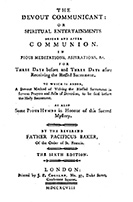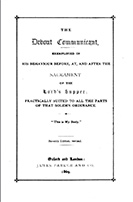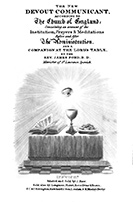The Devout Communicant
“The former tenant of our house, a priest, had died in the back drawing room. Air, musty from having been long enclosed, hung in all the rooms, and the waste room behind the kitchen was littered with old useless papers. Among these I found a few paper-covered books, the pages of which were curled and damp: The Abbot, by Walter Scott, The Devout Communicant and The Memoirs of Vidocq. I liked the last best because its leaves were yellow.”
-“Araby” (D 29)
Among the dead priest’s books, the narrator of “Araby” discovers a volume entitled The Devout Communicant. Of all the titles that appear in Dubliners, this particular book is the most difficult to positively identify. R.B. Kershner describes three distinct texts that Joyce might be referring to at the beginning of “Araby,” and each has its own implications for Joyce’s story (Joyce, Bakhtin, and Popular Literature 47). The most likely book for a Catholic priest to own would be Pacific's Baker’s The Devout Communicant; or spiritual entertainments before and after communion (1761), a devotional work written by an English Franciscan who converted to Catholicism as an adult and trained for the priesthood at Douai. Its small duodecimo format and inferior printing made it an inexpensive option for daily devotion. In addition to Baker’s work designed for Catholic spirituality, a number of Protestant devotionals share a similar title. In the late seventeenth century, Abednego Seller penned The Devout Communicant Exemplified in his Behaviour Before, at, and after the Sacrament of the Lord's Supper: Practically Suited to all the Parts of That Solemn Ordinance (1686), which was intended to be a practical manual for members of the Church of England. Baker clearly based his work on the popularity and form of this earlier text. The edition of Seller’s work included here is part of an Oxford Devotional Series published by James Parker and Co. in an attempt to revive once popular devotional practices and titles in the second half of the nineteenth century. A reworking of Seller’s text, The New Devout Communicant (1815) written by James Ford also addressed an Anglican congregation on the subject of the Lord’s Supper and would be equally unlikely reading material for a priest. Each of these texts offers a different vision of the dead priest and his reading habits, and together they show a range of devotional texts available to Irish readers.



